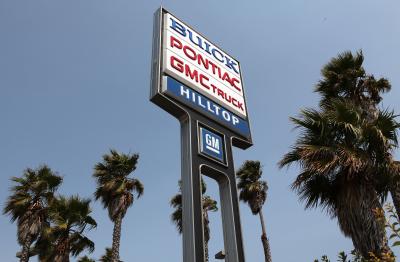
The front wheel hub on a Buick consists of a sealed bearing unit. This appears as an assembly on all front-wheel drive models. Unlike the old pressed-in bearings, the unit is removed and replaced as an assembly. Bolted to the knuckle, the hub bearing assembly mates to the front drive shaft and then allows the front brake rotor to seat against it. Although not a delicate procedure to perform in the comfort of your driveway, mechanical know-how and some specialty tools will make this task doable.
Start the repair by parking the Buick on a flat and hard surface and then applying the parking brake. Leave the ignition key in the first forward click position, but make sure all electrical components are shut off so as not to drain the battery during the procedure. This step will allow you to move the front wheels so you can get the required tools onto the hard to access bolts when the time comes. Remove the front hubcap of the wheel with the faulty bearing and then crack the lug nuts loose. Only turn the lug nuts one-eighth of a turn to break them loose and then lift the front of the vehicle with a jack. Place the Buick onto jack stands by placing them under the front frame rail. On a hot day with a paved driveway, place a board under each jack stand so it does not dig into the asphalt. Never use the lifting jack as a support because jacks can fail. Lift the entire front axle so you can move the wheel in back and forth as needed. By lifting only one side, the other wheel on the ground will prevent you from being able to turn the wheel and defeat the purpose of unlocking the steering column by the ignition key position.
Once the front axle is raised, remove the lug nuts and then remove the tire. To compress the caliper piston, use a 6-inch C-clamp and place it over the caliper and pad assembly. Compress the piston slightly and slowly until there is movement side to side from the caliper. You do not need to fully compress the piston. You just need to loosen it enough to allow removal and re-installation.
Remove the caliper carrier bolts on the back of the knuckle using a breaker bar and suitable socket. Remove the caliper, pads and carrier as an assembly. This will save a couple of steps by not having to remove the caliper, the pads and then the carrier. Hang the caliper to the coil spring out of the way with a metal hook so you don't damage the rubber brake hose. Removing the rotor requires a delicate procedure. If you're lucky, the rotor will loosen off the wheel hub bearing once the caliper assembly is removed. If you're not lucky, you will have to shock the rotor to separate the corrosion that is fusing it to the hub flange. A dead-blow rubber mallet, some penetrating lubricant and determination should work. Clean the inside mating surface of the rotor to remove any rust or other corrosives that will prevent it from sitting true to the new hub. While an angled die grinder with a reconditioning disc works well for this, if pneumatic tools are not available to you, you can use a piece of emery cloth or fine-grit sandpaper, but it will take a while.
Most Buick front-wheel hub bearing assemblies employ an ABS/speed sensor wire that is actually part of the assembly. Follow the wire from its connection to the bearing until you locate the plug connection on the frame rail and then disconnect it. Remove all the ABS/speed sensor wire retainers. These plastic snap-rings prevent the wire from getting damaged from moving chassis components.
Remove the axle nut. This requires a large socket. Most often a 34 mm or 36 mm socket is required. Remove the nut and washer and then gently pound on the spindle of the axle with a rubber dead-blow mallet to break it free from the bearing assembly. Never use a metal hammer unless you replace the axle nut flush to the spindle so you do not damage the spindle.
There are three bearing retaining bolts on the back of the knuckle. These bolts may require the movement of the wheel to allow a suitable socket to get a bite onto the bolt heads.
A hub/bearing puller or a slide hammer with a lot of penetrating lubricant are all that's left to remove the bearing assembly from the knuckle.
Re-installation of the front wheel hub bearing is simply reversing the removal procedure. There are, however, a couple of things to consider. The backing plate of the knuckle that protects the inside surface of the rotor is pressed between the knuckle and wheel hub bearing. Any corrosives should be sanded off of this on both sides. The inside mating surface and front mating surface of the knuckle should also be cleaned thoroughly of any corrosives. If the new wheel hub bearing is installed onto existing corrosives, it can sit untrue to the knuckle and cause problems when driving.
Line the ABS/speed sensor wire through the hole in the backing plate and then align it to the knuckle. Hand thread the wheel hub bearing bolts through the back of the knuckle. You'll also have to align the internal grooves of the bearing to match the splines on the spindle. When tightening the wheel hub bearing bolts, tighten each bolt about five turns each and then move to the next one. This will draw the bearing in evenly so it doesn't get cocked in the knuckle.
Be sure to torque all bolts and nuts to proper torque specifications while putting everything back together.